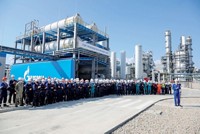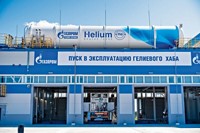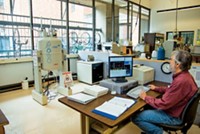Advertisement
Grab your lab coat. Let's get started
Welcome!
Welcome!
Create an account below to get 6 C&EN articles per month, receive newsletters and more - all free.
It seems this is your first time logging in online. Please enter the following information to continue.
As an ACS member you automatically get access to this site. All we need is few more details to create your reading experience.
Not you? Sign in with a different account.
Not you? Sign in with a different account.
ERROR 1
ERROR 1
ERROR 2
ERROR 2
ERROR 2
ERROR 2
ERROR 2
Password and Confirm password must match.
If you have an ACS member number, please enter it here so we can link this account to your membership. (optional)
ERROR 2
ACS values your privacy. By submitting your information, you are gaining access to C&EN and subscribing to our weekly newsletter. We use the information you provide to make your reading experience better, and we will never sell your data to third party members.
Business
Helium supplies are tightening up again
Buoyant demand and supply disruptions narrow flow of the noble gas to scientific instrument users
by Marc S. Reisch
March 14, 2018
| A version of this story appeared in
Volume 96, Issue 12

Hiccups in global helium supply lines, along with improving demand in a growing economy, are leading to shortages of the noble gas. As a result, some helium distributors are allocating supplies to operators of scientific instruments and other customers in the U.S.
According to the industrial gas firm Linde, supply interruptions in the Middle East and allocations of helium from the U.S. Bureau of Land Management’s Texas helium reserves have restricted the company’s ability to supply customers. Linde says it is now allocating helium in “a fair and reasonable way.”
Some scientists who use the element to chill the magnets in nuclear magnetic resonance spectrometers say they can only get 75% of their normal allocation. Helium is also used as a sample carrier gas in mass spectrometers.
Samuel Burton, BLM’s field manager, tells C&EN that the bureau is “seeing increased demand by federal agencies, including the National Aeronautics & Space Administration,” for the element.
Federal agencies take precedence over private companies, which “will not get as much as they might want,” Burton says.
Supplies from BLM will be further restricted when the facility shuts down from March 18–25 for scheduled maintenance. On the bright side, when the facility returns online, it will be able to slightly increase output, points out Phil Kornbluth, a consultant who previously ran BOC’s and Matheson Tri-Gas’s helium operations.
Allocation of the gas by major helium suppliers continues a period of uncertainty that goes back to disruptions of supply from Qatar in June 2017, when Saudi Arabia blocked shipments out of the country, Kornbluth adds. Though the interruption was short lived, more recent upsets in supply from Qatar as well as from other U.S. and international producers have tightened supplies during a period of increasing demand, he says.
Kornbluth predicts that shortages may get worse before conditions improve in 2019, when new capacity comes online in Qatar.
Other new sources are on the way. Linde and other industrial gases firms recently reached deals to distribute helium from a Gazprom plant in eastern Russia set to come online in 2021.
CORRECTION: This article was updated on March 15, 2018, to correct the name of the company commenting on supply interruptions. It is Linde, not Praxair.





Join the conversation
Contact the reporter
Submit a Letter to the Editor for publication
Engage with us on Twitter